
How Home Economics helped cut our food costs
Much as I love to cook, sometimes I wish someone else would do the meal planning for me.
That’s why I fell upon food blogger Jane Ashley’s cook book with cries of joy. Jane blogs over at Eat Not Spend, and her book, Home Economics*, is all about ‘how eat like a king on a budget’.
Like her blog, Home Economics does the hard work for you. It provides menu plans for a week, complete with recipes and shopping lists designed to feed a family of four for £35. Think about that – just a fiver a day to feed four people!
There are meal plans for seven different weeks, including weeks that are lower carb, vegetarian, vegan and gluten-free, plus additional basic recipes, budget baking and tips on store cupboard ingredients and essential equipment.
I was raring to give it a go, thanks to the range of recipes from round the world and the beautiful food photography.
Planning
I decided (appropriately enough) to start with Week 1.
For each meal plan, Jane includes:
- shopping list with prices and a photo of all the food
- menu for a week, plus a few treat ideas
- recipes for the main meals
I started by checking the shopping list, to see which food we already had in the house:
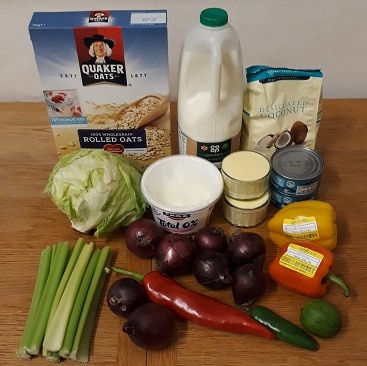
Food we already had
(Spot the pots of home-made butter, resurrected from the freezer)
I also recommend checking which store cupboard ingredients are needed for specific recipes. The £35 a week cost depends on having a well-stocked store cupboard. The book has a list of store cupboard essentials, but the good news is that you don’t have to buy everything on day 1, but just the stuff for your meal plan.
To cook the meals in Week 1, including the sweet treats, here’s the store cupboard stuff required:
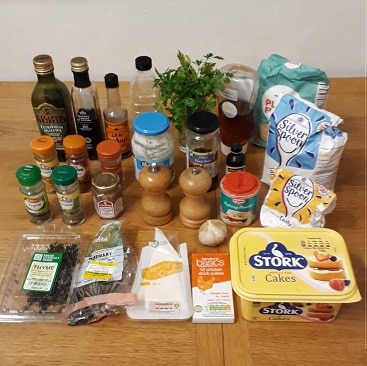
Most of it is pretty standard if you’re used to cooking from scratch – olive oil, mayonnaise, stock cubes, salt, pepper, flour, sugar and so on. But I’m not sure how often everyone has for example fresh herbs to hand. If you didn’t have many store cupboard ingredients, you’d need to spend more.
With Week 1 for example, I had to buy capers, needed for the caesar style dressing and tartar sauce, but not included on the weekly shopping list.
Shopping
After tweaking the shopping list based on what we already had, and what I needed to add to the store cupboard, I headed to the supermarket.
I was surprised how helpful I found the photo of the shopping, to see which food came from value ranges versus ordinary supermarket own brand. With some foods I’m quite to use value options – pasta, for example – but after doing the Live Below The Line charity challenge, when I fed myself on £1 a day for 5 days, I’m not keen to return to value range jam.
The Week 1 shopping list was priced at £33.90. Here’s what I bought from the list, which cost £30.71:
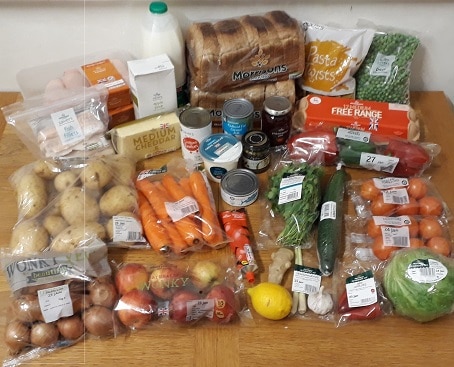
Food bought from the Week 1 shopping list
I also spent another £8.43 buying extras. The meal plans are based on a super-tight budget. If you can afford a bit more, you might want to add items, depending on what your family like eating.
So for example, I bought more fruit and a choice of breakfast cereals. I also couldn’t resist live yeast reduced to 13p, even though it’s still in the freezer waiting to be used!
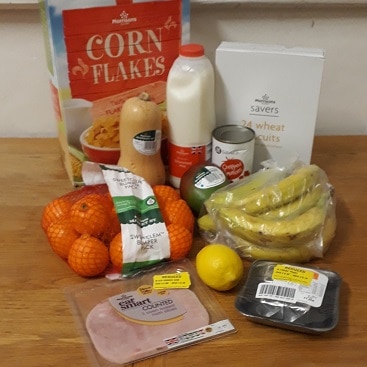
Added extras, while still keeping costs low
However, as the core shopping list was so cheap, I could add stuff and still cut costs compared to our normal shopping. I ended up spending just under £40, topping up the food we had in the house, and then stayed away from the shops for a week.
More ways to save money on your food shopping
Cooking
The recipes in Home Economic are speedy, easy to follow and taste great.
I really enjoyed trying some new meals, like the Normandy Chicken cooked with apples, and my first ever attempt at Dauphinoise potatoes.
Some recipes – like All in One Baked Chicken with Roasted Veg and Tuna Pasta Bake – were more familiar. But elsewhere, the book pushed me to make extras I wouldn’t normally, like tartar sauce and Caesar style dressing, which my husband particularly appreciated.
Home-made fish and chips, using inexpensive frozen white fish, was a highlight for the whole family. We even snuck in a Butternut Tagine the evening before starting Week 1, using the butternut squash on offer at Morrisons.
Combining recipes as meal plans meant Jane also suggests some great time saving tips, like cooking double the pasta for the Tuna Pasta Bake, so you can use the other half as Pasta Frittata, or baking extra chicken thighs to use for sandwiches another day.
I suspect you’ll save more money if you try the meal plans, but you can also dip in and out of recipes, if you don’t want to stick to a single book for a whole week.
My photos don’t do justice to the recipes, and are nowhere near as good as the photos in the book, but this should give you an idea of the variety of meals we ate:
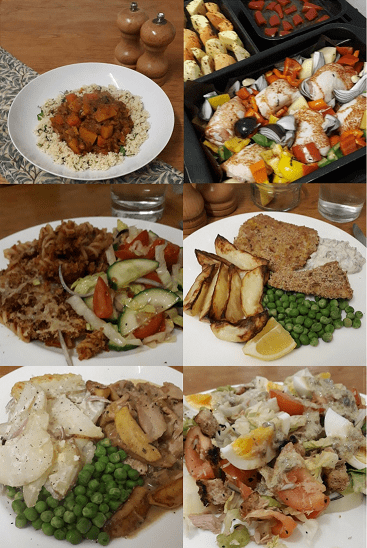
Meals from Home Economics
Clockwise from top left: Butternut Tagine, Baked Chicken and Roast Vegetables, Fish and Chips with Peas and Tartar Sauce, Tuna Nicoise Salad, Normandy Chicken with Dauphinoise Potatoes and Tuna Pasta Bake with Salad.
One thing to note is that although the shopping list and meal plan mention breakfast and lunches, the recipes only include specific quantities for the evening meals. In practice, my husband liked taking in leftovers from the main meals for lunch the next day, so we didn’t necessarily stick to the lunches listed.
When doing a different week, I’ll probably buy a bit more to bulk out the main meals. Week 1’s tight budget allows one chicken thigh per person per meal, for example, but it doesn’t cost loads to buy extra if you can. Costs are also kept down by for example using up the frozen peas in a single week. Another time, I’d add an extra vegetable for variety like broccoli or frozen beans, and then eat the peas over a couple of weeks rather than crammed into one.
Benefits of the Home Economics cook book
I really enjoyed trying one of the weekly meal plans, and am excited about cooking loads more from Home Economics.
For me, the main benefits were:
- Cut our weekly food costs to £40, even including some extra items
- Helped cut food waste, as you just buy items for the meals needed
- Saved time, by providing a meal plan, recipes and shopping list I could tweak based on what we had in the house
- Stopped shopping trips, as we were able to buy everything we needed for a week in one go
- Easy to follow tasty budget recipes, with lovely photos for inspiration
- Pushed me to try some new recipes rather than getting stuck in a rut!
I might have the odd gripe, like the missing oven temperature in the recipe for Dauphinoise Potatoes, but I really do recommend this book.
The price is listed at £14.99, but Home Economics was on sale in Tesco for £7, and you can buy it online for £10.49 here*.
Edited to add: Sue from The Cottage at the End of a Lane pointed out that borrowing cook books from the library is a great way to try them for free. Plus, I spotted that Moneywise is running a competition to win one of 10 free copies of Home Economics, if you enter before 28 February. Good luck!
Now over to you – do weekly meal plans appeal? If you’ve got Home Economics, what do you think of it?
I’m joining the meal planning linky hosted by Katy over at KatyKicker and Naomi from The Organised Life Project.
*indicates an affiliate link, so anything you buy through it will help support the blog, as I will get a small commission at no cost to you. Many thanks!
Pin for later:


I never buy recipe books new so have this on order from the library – there’s a bit of a waiting list – half Suffolk wants to try it!
Good point about borrowing a copy from the library. Hope your reservation shows up soon!
Out of curiosity, why do you think you saved more this week than you usually would? Do you think it’s planning a connected weeks menu rather than 7 separate meals? Or buying less food generally? I’ve tried different meals from the website- loved the bean burgers- but not a whole week.
I think we spent less from a combination of just buying food for inexpensive recipes for one week, with little over, and not nipping out for extra top up shops. I also cooked some of the biscuits suggested, rather than buying snacks.
Thanks, I was just interested as you’re normally a very careful shopper anyway.
My daughter has just had a baby and is on a very tight budget. I’ve just ordered this for her as it sounds like just what she needs. Thank you for recommending it.
Author
Hope your daughter likes the book! There are loads of recipes I’m looking forward to trying, and great to know they’re inexpensive.
An interesting post. I’m not sure I’d like someone else to decide what I’ll be eating for the week (though I suppose my husband has has his meals decided for him for years), but I expensive recipes are always useful. I definitely go along with the idea of planning to have leftovers i.e. Cooking extra with a specific recipe in mind for the next day.
Occasionally I find it an enormous relief for someone else to decide what I’m eating for a week! Home Economics can definitely be used as an ordinary cook book for budget recipes, but suspect you’d make the most savings by following the meal plans.
Wow, this system looks amazing! I’m off to have a look at the book. Thanks so much for linking up to the meal planning linky.
Book worked well for us. Ended up cooking the coconut chicken curry a few days later, and my husband loved it.
This book sounds really interesting and I’m going to go enter that competition now! Thanks for linking up and hope to see you joining again soon x
Fingers crossed you win a copy Katy!
Yes, I’ve got this book and I think it’s brilliant. I’ve not followed a meal plan yet as we’re still doing the rationing challenge, but I might in the near future.
In the meantime I’ll just pore over the lovely photos, there’s something very satisfying in looking at shelves of someone else’s shopping
A book essay, also known as a book review, is a written response to a literary work. By visiting this site https://bestwritersonline.com/ you nay find the bect writers for this work. This type of assignment provides students with the opportunity to analyze the text from a particular perspective and improve their reading skills. Essays are usually assigned to students of middle or high school level. It is important to follow some simple rules when writing these types of essays.
I Need A Hacker To Recover My Lost Investment? Go To Lost Recovery Masters
Hello guys, I’m Lyne Azabal from France. In my investment with Acstons-Cc, I also lost 17 lakhs. Trading using the Acstons. cc app generated a profit of 197,153 USD after paying tax and a 25% fee, however they would not release my profit and all of my Bitcoins were frozen. I called my pals, who suggested I try LOST RECOVERY MASTERS, and to my astonishment they were able to assist me get back 89% of my money. Despite the fact that I didn’t get all of it back, I’m still really appreciative of LOST RECOVERY MASTERS
For advice on recovering cryptocurrencies, get in touch with Lost Recovery Masters You can also ask them questions about any firm you wish to deal with.
Contact them: Whatsapp (+44(7537)-105921) Email (Support@lostrecoverymasters.com) Learn More https://lostrecoverymasters.wixsite.com/recoverbitcoin2024